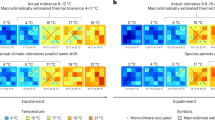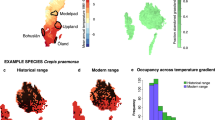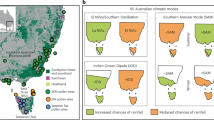Abstract
Conservation decisions are informed by twenty-first-century climate impact projections that typically predict high extinction risk1,2. Conversely, the palaeorecord shows strong sensitivity of species abundances and distributions to past climate changes3, but few clear instances of extinctions attributable to rising temperatures. However, few studies have incorporated palaeoecological data into projections of future distributions. Here we project changes in abundance and conservation status under a climate warming scenario for 187 European and North American plant taxa using niche-based models calibrated against taxa–climate relationships for the past 21,000 years. We find that incorporating long-term data into niche-based models increases the magnitude of projected future changes for plant abundances and community turnover. The larger projected changes in abundances and community turnover translate into different, and often more threatened, projected IUCN conservation status for declining tree taxa, compared with traditional approaches. An average of 18.4% (North America) and 15.5% (Europe) of taxa switch IUCN categories when compared with single-time model results. When taxa categorized as ‘Least Concern’ are excluded, the palaeo-calibrated models increase, on average, the conservation threat status of 33.2% and 56.8% of taxa. Notably, however, few models predict total disappearance of taxa, suggesting resilience for these taxa, if climate were the only extinction driver. Long-term studies linking palaeorecords and forecasting techniques have the potential to improve conservation assessments.
This is a preview of subscription content, access via your institution
Access options
Subscribe to this journal
Receive 12 print issues and online access
$209.00 per year
only $17.42 per issue
Buy this article
- Purchase on Springer Link
- Instant access to full article PDF
Prices may be subject to local taxes which are calculated during checkout




Similar content being viewed by others
References
Urban, M. C. Accelerating extinction risk from climate change. Science 348, 571–573 (2015).
Garcia, R. A., Cabeza, M., Rahbek, C. & Araújo, M. B. Multiple dimensions of climate change and their implications for biodiversity. Science 344, 1247579 (2014).
Willis, K. J. & MacDonald, G. M. Long-term ecological records and their relevance to climate change predictions for a warmer world. Annu. Rev. Ecol. Evol. Syst. 42, 267–287 (2011).
Nogués-Bravo, D. Predicting the past distribution of species climatic niches. Glob. Ecol. Biogeogr. 18, 521–531 (2009).
Dietl, G. P. & Flessa, K. W. Conservation paleobiology: putting the dead to work. Trends Ecol. Evol. 26, 30–37 (2012).
Maguire, K. C., Nieto-Lugilde, D., Fitzpatrick, M. C., Williams, J. W. & Blois, J. L. Modeling species and community responses to past, present, and future episodes of climatic and ecological change. Annu. Rev. Ecol. Evol. Syst. 46, 343–368 (2015).
Dawson, T. P., Jackson, S. T., House, J. I., Prentice, I. C. & Mace, G. M. Beyond predictions: biodiversity conservation in a changing climate. Science 332, 53–58 (2010).
Williams, J. W. et al. The ice age ecologist: testing methods for reserve prioritization during the last global warming. Glob. Ecol. Biogeogr. 22, 289–301 (2012).
Maiorano, L. et al. Building the niche through time: using 13,000 years of data to predict the effects of climate change on three tree species in Europe. Glob. Ecol. Biogeogr. 22, 302–317 (2013).
Willis, K. J. & Bhagwat, S. A. Biodiversity and climate change. Science 326, 806–807 (2009).
Barnosky, A. D. et al. Approaching a state shift in Earth’s biosphere. Nature 486, 52–58 (2012).
Willis, K. J., Bailey, R. M., Bhagwat, S. A. & Birks, H. J. B. Biodiversity baselines, thresholds and resilience: testing predictions and assumptions using palaeoecological data. Trends Ecol. Evol. 25, 583–591 (2010).
Lorenzen, E. D. et al. Species-specific responses of Late Quaternary megafauna to climate and humans. Nature 479, 359–364 (2011).
Brewer, S., Jackson, S. T. & Williams, J. W. Paleoecoinformatics: applying geohistorical data to ecological questions. Trends Ecol. Evol. 27, 104–112 (2012).
Barbet-Massin, M., Thuiller, W. & Jiguet, F. How much do we overestimate future local extinction rates when restricting the range of occurrence data in climate suitability models? Ecography 33, 878–886 (2010).
Veloz, S. D. et al. No-analog climates and shifting realized niches during the late Quaternary: implications for 21st-century predictions by species distribution models. Glob. Change Biol. 18, 1698–1713 (2012).
Hutchinson, G. E. Concluding remarks. Cold Spring Harb. Symp. Quant. Biol. 22, 415–427 (1957).
Araújo, M. B. & New, M. Ensemble forecasting of species distributions. Trends Ecol. Evol. 22, 42–47 (2007).
IUCN Guidelines for using the IUCN Red List Categories and Criteria Version 10 (IUCN, 2013).
Jackson, S. T. & Overpeck, J. T. Responses of plant populations and communities to environmental changes of the late quaternary. Paleobiology 26, 194–220 (2000).
Elith, J., Kearney, M. & Phillips, S. The art of modelling range-shifting species. Methods Ecol. Evol. 1, 330–342 (2010).
Birks, H. J. B. & Birks, H. H. Biological responses to rapid climate change at the Younger Dryas-Holocene transition at Krákenes, western Norway. Holocene 18, 19–30 (2008).
Jackson, S. T. & Weng, C. Late Quaternary extinction of a tree species in eastern North America. Proc. Natl Acad. Sci. USA 96, 13847–13852 (1999).
Prentice, I. C. & Webb, T. Pollen percentages, tree abundances and the Fagerlind effect. J. Quat. Sci. 1, 35–43 (1986).
Ordonez, A. & Williams, J. W. Climatic and biotic velocities for woody taxa distributions over the last 16000 years in eastern North America. Ecol. Lett. 16, 773–781 (2013).
Feurdean, A. et al. Tree migration-rates: narrowing the gap between inferred post-glacial rates and projected rates. PLoS ONE 8, e71797 (2013).
Brook, B. W., Sodhi, N. S. & Bradshaw, C. J. A. Synergies among extinction drivers under global change. Trends Ecol. Evol. 23, 453–460 (2007).
Fordham, D. et al. Population dynamics can be more important than physiological limits for determining range shifts under climate change. Glob. Change Biol. 19, 3224–3237 (2013).
Moritz, C. et al. Impact of a century of climate change on small-mammal communities in Yosemite National Park, USA. Science 322, 261–264 (2008).
Fordham, D. A., Brook, B. W., Moritz, C. & Nogués-Bravo, D. Better forecasts of range dynamics using genetic data. Trends Ecol. Evol. 29, 436–443 (2014).
Davis, B. A. S. et al. The temperature of Europe during the Holocene reconstructed from pollen data. Quat. Sci. Rev. 22, 1701–1716 (2003).
Acknowledgements
D.N.-B. thanks det Frie Forskningsrads forskerkarriereprogram Sapere Aude. D.N.-B., B.G.H. and C.R. thank the Danish National Research Foundation for its support of the Center for Macroecology, Evolution, and Climate. J.W.W. was supported by the National Science Foundation (EAR-0844223, DEB-1257508) and the Climate, People, and Environment Program at the University of Wisconsin. J.S. and P.V. were supported by the British Broadcasting Corporation, BBC. B.G.H. also thanks the Marie Curie Actions under the Seventh Framework Programme (PIEF-GA-2009-252888) and B.G.H. and C.R. acknowledge the support of Imperial College London’s Grand Challenges in Ecosystems and the Environment Initiative.
Author information
Authors and Affiliations
Contributions
D.N.-B. conceived and headed the overall project. D.N.-B., S.V., B.G.H., S.C.B., J.W.W. and C.R. provided the main conceptual and methodological inputs. S.C.B. and J.W.W. provided the fossil pollen databases. J.S. and P.V. provided the palaeoclimatic simulations. B.G.H. performed the climate envelope model analysis. D.N.-B. performed the IUCN conservation status estimates and the model validation analysis. S.V. performed the niche-overlap and non-analogue climate analyses. D.N.-B. conducted the analysis on the differences of CO2 concentrations across time and the effect of abundance on the magnitude of change among IUCN categories. D.N.-B., S.V., B.G.H., S.C.B., J.W.W. and C.R. wrote most of the manuscript, with input from B.D., J.S. and P.V.
Corresponding author
Ethics declarations
Competing interests
The authors declare no competing financial interests.
Supplementary information
Supplementary Information
Supplementary Information (PDF 1158 kb)
Rights and permissions
About this article
Cite this article
Nogués-Bravo, D., Veloz, S., Holt, B. et al. Amplified plant turnover in response to climate change forecast by Late Quaternary records. Nature Clim Change 6, 1115–1119 (2016). https://doi.org/10.1038/nclimate3146
Received:
Accepted:
Published:
Issue Date:
DOI: https://doi.org/10.1038/nclimate3146
This article is cited by
-
The drivers of plant community composition have shifted from external to internal processes over the past 20,000 years
Communications Earth & Environment (2023)
-
A global analysis of habitat fragmentation research in reptiles and amphibians: what have we done so far?
Biodiversity and Conservation (2023)
-
StableClim, continuous projections of climate stability from 21000 BP to 2100 CE at multiple spatial scales
Scientific Data (2020)
-
A simulated Northern Hemisphere terrestrial climate dataset for the past 60,000 years
Scientific Data (2019)
-
Anthropogenic range contractions bias species climate change forecasts
Nature Climate Change (2018)



